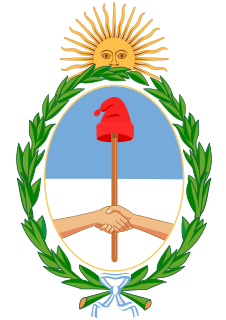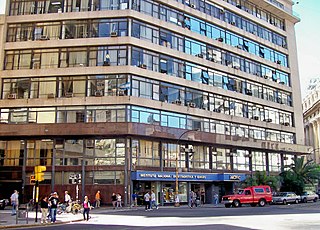
This article is about voting, elections, and election results in Argentina. For details of Argentine government institutions and political parties, see Politics of Argentina.

Guasayán Department is a departamento of the province of Santiago del Estero, Argentina.

Departments form the second level of administrative division, and are subdivided in municipalities. They are extended in all of Argentina except for the Province of Buenos Aires and the Autonomous City of Buenos Aires, the national capital, each of which has different administrative arrangements.

Termas de Río Hondo is a spa city in Santiago del Estero Province, Argentina. It has 27,838 inhabitants as per the 2001 census [INDEC]. It is located on the banks of the Dulce River, 65 km north of the provincial capital Santiago del Estero, near the artificial Río Hondo Lake.

La Banda is a city in the province of Santiago del Estero, Argentina. It has about 95,000 inhabitants as per the 2001 census [INDEC], making it the second largest in the province. It is the head town of the Banda Department.
The 1817 Santiago del Estero earthquake took place in the province of Santiago del Estero, Argentina, on 4 July at about 05:30 PM. It was estimated to be 7.0 on the Richter magnitude scale. Its epicenter was at 28°00′S64°30′W, at a depth of 30 km.

Loreto is a city located in central Argentina in the southwest of the province of Santiago del Estero, Argentina. It has 9,854 inhabitants as per the 2001 census [INDEC], and is the head town of the Loreto Department. It is located 59 km south from the provincial capital Santiago del Estero, on National Route 9.

Añatuya is a city in the province of Santiago del Estero, Argentina. It has 23.286 inhabitants as per the 2010 census [INDEC], and is the head town of the General Taboada Department. It lies on the southeast of the province, east of the Salado River, and about 150 km from the provincial capital Santiago del Estero.

Vicecomodoro Ángel de la Paz Aragonés Airport is located 6 kilometres (4 mi) northwest of downtown Santiago del Estero, the capital of Santiago del Estero Province in Argentina. The airport covers an area of 526 hectares and is operated by Aeropuertos Argentina 2000.
Cruz Alta Department is a department located in the east of the Tucumán Province, Argentina. In 2001 its population was 162,240 largely located in the Banda del Río Salí-Alderetes Area (northwest). The Department seat is the city of Banda del Río Salí.
The National University of Santiago del Estero is an Argentine national university located in the capital of Santiago del Estero Province. Its 1973 establishment gathered the existing Tucumán University school of agronomy (1949) and the Córdoba University forestry institute (1958), as well as new schools created for the purpose.
Árraga is a municipality and village in Santiago del Estero in Argentina. It is the head district of the Silípica Department to the southwest of the province of Santiago del Estero. It is located 32 km from the provincial capital city of Santiago del Estero (capital), south along National Route 9.

Averías is a municipality and village in the General Taboada department, province of Santiago del Estero in Argentina. It is located approximately 229 km from the provincial capital city of Santiago del Estero.

Bandera is a municipality and town in Santiago del Estero Province in Argentina. It is the capital of the Belgrano Department, at the edge of National Route 98. Bandera is located some 272 km from the provincial capital, which is reached by National Route No. 34 and Provincial Route No. 21. The town has 5,335 inhabitants, according to the 2001 census, 67% of the total population of the department.

The Republic of Tucumán was a short-lived state centered on the town of San Miguel de Tucumán in today's Argentina that was formed after the collapse of central authority in 1820, and that broke up the next year. The "Republic" remained a political unit within the United Provinces of the Río de la Plata.

Capital Department is a department of Argentina in Santiago del Estero Province. The capital city of the department is situated in Santiago del Estero.

Tren al Desarrollo is an elevated commuter rail service between the cities of Santiago del Estero and La Banda in Santiago del Estero Province. Trains run on 1,676 mm Mitre Railway tracks were disused. The line also crosses the Puente Negro, a bridge that had been closed for over 40 years.













